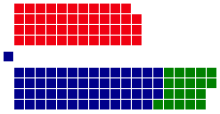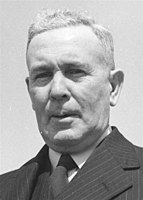Australian federal election, 1949

Multi tool use
| ||||||||||||||||||||||||||||||||||
All 121 seats of the House of Representatives 61 seats were needed for a majority in the House 42 (of the 60) seats of the Senate | ||||||||||||||||||||||||||||||||||
|---|---|---|---|---|---|---|---|---|---|---|---|---|---|---|---|---|---|---|---|---|---|---|---|---|---|---|---|---|---|---|---|---|---|---|
| ||||||||||||||||||||||||||||||||||
| ||||||||||||||||||||||||||||||||||
Federal elections were held in Australia on 10 December 1949. All 121 seats in the House of Representatives and 42 of the 60 seats in the Senate were up for election. The incumbent Labor Party, led by Prime Minister Ben Chifley, was defeated by the opposition Liberal–Country coalition under Robert Menzies. Menzies became prime minister for a second time, his first term having ended in 1941.
The number of MPs in both houses had been increased at the election, and single transferable vote under a proportional voting system had been introduced in the Senate. Though Labor lost government, Labor retained a Senate majority at the election. However, this ended at the 1951 election. With the Senate changes in place, Labor has not held a Senate majority since.
Future Prime Ministers William McMahon and John Gorton both entered parliament at this election.
Contents
1 Issues
2 Results
2.1 House of Representatives
2.2 Senate
3 Seats changing hands
4 Electoral reform
5 Significance
6 See also
7 Notes
8 Sources
Issues
The election hinged on the policies of the Federal Labor Government, especially bank nationalisation. Prime Minister Chifley intended to bring all of the banks under Government control, a socialist policy which the Coalition argued was not in the country's interest. The Coalition promised to end unpopular wartime rationing. The election took place against the background of the 1949 Australian coal strike, the developing Cold War and growing fears of communism.
Robert Menzies broke new ground in using the radio as his primary method of reaching voters.[1]
Results
House of Representatives

Labor: 47 seats
Liberal Party: 55 seats
Country: 19 seats
| Party |
Votes |
% |
Swing |
Seats |
Change |
||
|---|---|---|---|---|---|---|---|
| |
Liberal–Country coalition |
2,314,143 |
50.26 |
+6.61 |
74 |
+45 |
|
| |
Liberal |
1,813,794 |
39.39 |
+6.44 |
55 |
+37 |
|
| |
Country |
500,349 |
10.87 |
+0.17 |
19 |
+8 |
|
| |
Labor |
2,117,088 |
45.98 |
–3.73 |
47 |
+4 |
|
| |
Communist |
40,941 |
0.89 |
–0.60 |
0 |
0 |
|
| |
Lang Labor |
32,870 |
0.71 |
–0.88 |
0 |
–1 |
|
| |
Independents |
99,368 |
2.16 |
+0.34 |
0 |
–1 |
|
| |
Total |
4,604,410 |
|
|
121 |
+47 |
|
Two-party-preferred .mw-parser-output .nobold{font-weight:normal} (estimated) | |||||||
| |
Liberal–Country coalition |
WIN |
51.00 |
+5.10 |
74 |
+45 |
|
| |
Labor |
49.00 |
−5.10 |
47 |
+4 |
||
Senate
| Party |
Votes |
% |
Swing |
Seats Won |
Seats Held |
Change |
||
|---|---|---|---|---|---|---|---|---|
| |
Liberal–Country coalition |
2,113,447 |
50.41 |
+7.08 |
23 |
26 |
+23 |
|
| |
Liberal–Country joint ticket |
1,871,849 |
44.65 |
+6.53 |
16 |
N/A |
N/A |
|
| |
Liberal |
241,598 |
5.76 |
+0.55 |
7 |
21 |
+19 |
|
| |
Country |
N/A |
N/A |
N/A |
0 |
5 |
+4 |
|
| |
Labor |
1,881,956 |
44.89 |
–7.17 |
19 |
34 |
+1 |
|
| |
Communist |
87,958 |
2.10 |
+2.10 |
0 |
0 |
0 |
|
| |
Protestant People's |
37,441 |
0.89 |
–2.13 |
0 |
0 |
0 |
|
| |
Independents / Ungrouped |
71,723 |
1.71 |
+1.03 |
0 |
0 |
0 |
|
| |
Total |
4,192,525 |
|
|
42 |
60 |
+24 |
|
Seats changing hands
| Seat |
Pre-1949 |
Swing |
Post-1949 |
||||||
|---|---|---|---|---|---|---|---|---|---|
| Party |
Member |
Margin |
Margin |
Member |
Party |
||||
Australian Capital Territory, ACT |
new division |
3.8 |
Lewis Nott |
Independent |
|
||||
Ballaarat, Vic |
|
Labor |
Reg Pollard |
3.1 |
3.1 |
0.4 |
Alan Pittard |
Liberal |
|
Bass, Tas |
|
Labor |
Claude Barnard |
7.0 |
6.8 |
0.6 |
Bruce Kekwick |
Liberal |
|
Blaxland, NSW |
|
Lang Labor |
notional - new seat |
N/A |
53.4 |
3.4 |
Jim Harrison |
Labor |
|
Bowman, Qld |
|
Labor |
notional - new seat |
N/A |
1.4 |
3.8 |
Malcolm McColm |
Liberal |
|
Corio, Vic |
|
Labor |
John Dedman |
7.2 |
6.7 |
0.3 |
Hubert Opperman |
Liberal |
|
Curtin, WA |
|
Labor |
notional - new seat |
N/A |
13.8 |
11.2 |
Paul Hasluck |
Liberal |
|
Darling Downs, Qld |
|
Country |
Arthur Fadden |
N/A |
1.9 |
12.5 |
Reginald Swartz |
Liberal |
|
Dawson, Qld |
|
Labor |
notional - new seat |
N/A |
9.8 |
8.6 |
Charles Davidson |
Country |
|
Denison, Tas |
|
Labor |
John Gaha |
7.0 |
10.9 |
5.1 |
Athol Townley |
Liberal |
|
Farrer, NSW |
|
Country |
notional - new seat |
N/A |
58.8 |
8.8 |
David Fairbairn |
Liberal |
|
Forrest, WA |
|
Labor |
Nelson Lemmon |
2.3 |
4.4 |
2.8 |
Gordon Freeth |
Liberal |
|
Gwydir, NSW |
|
Labor |
William Scully |
1.2 |
9.2 |
5.1 |
Thomas Treloar |
Country |
|
Hume, NSW |
|
Labor |
Arthur Fuller |
4.2 |
5.9 |
1.0 |
Charles Anderson |
Country |
|
Indi, Vic |
|
Country |
John McEwen |
N/A |
59.7 |
9.7 |
William Bostock |
Liberal |
|
Kingston, SA |
|
Labor |
notional - new seat |
N/A |
8.4 |
1.6 |
Jim Handby |
Liberal |
|
Lawson, NSW |
|
Labor |
notional - new seat |
N/A |
7.6 |
5.8 |
Laurie Failes |
Country |
|
Leichhardt, Qld |
|
Labor |
notional - new seat |
N/A |
9.2 |
1.7 |
Tom Gilmore |
Country |
|
Lowe, NSW |
|
Labor |
notional - new seat |
N/A |
9.0 |
8.5 |
William McMahon |
Liberal |
|
McMillan, Vic |
|
Country |
notional - new seat |
N/A |
6.1 |
6.9 |
Geoffrey Brown |
Liberal |
|
McPherson, Qld |
|
Liberal |
notional - new seat |
N/A |
5.1 |
24.2 |
Arthur Fadden |
Country |
|
Mitchell, NSW |
|
Labor |
notional - new seat |
N/A |
12.8 |
6.9 |
Roy Wheeler |
Liberal |
|
Northern Territory, NT |
|
Independent |
Adair Blain |
N/A |
8.6 |
2.7 |
Jock Nelson |
Labor |
|
Paterson, NSW |
|
Labor |
notional - new seat |
N/A |
8.6 |
8.5 |
Allen Fairhall |
Liberal |
|
Riverina, NSW |
|
Labor |
Joe Langtry |
0.6 |
3.8 |
3.5 |
Hugh Roberton |
Country |
|
Robertson, NSW |
|
Labor |
Thomas Williams |
3.8 |
11.5 |
4.2 |
Roger Dean |
Liberal |
|
St George, NSW |
|
Labor |
notional - new seat |
N/A |
16.2 |
2.0 |
Bill Graham |
Liberal |
|
Sturt, SA |
|
Labor |
notional - new seat |
N/A |
8.9 |
2.8 |
Keith Wilson |
Liberal |
|
Swan, WA |
|
Labor |
notional |
N/A |
10.2 |
2.4 |
Bill Grayden |
Liberal |
|
Wannon, Vic |
|
Labor |
Don McLeod |
1.2 |
3.8 |
0.8 |
Dan Mackinnon |
Liberal |
|
Wimmera, Vic |
|
Country |
Winton Turnbull |
N/A |
5.6 |
14.9 |
William Lawrence |
Liberal |
|
- Members in italics did not contest their seat at this election.
Electoral reform
As of this election, single transferrable vote with proportional representation became the method for electing the Senate. This was to try to prevent the Senate from being dominated by one party, which had often occurred previously. For example, coming into this election the ALP held 33 of the 36 Senate seats, whilst the conservatives at the 1919 election held 35 of the 36 Senate seats. In addition, the House of Representatives was enlarged from 74 to 121 seats and the Senate from 36 members to 60 members. All 121 lower house seats, and 42 of the 60 upper house seats, were up for election.
Significance
The Chifley Government was defeated, ending the longest period of Labor Federal Government in Australian history up to that date (1941–49). Labor would not return to office until 1972. Robert Menzies became Prime Minister for the second time, and the Liberal Party of Australia won government federally for the first time.
See also
- Candidates of the Australian federal election, 1949
- Members of the Australian House of Representatives, 1949-1951
- Members of the Australian Senate, 1950–1951
Notes
^ Ian Ward, "The early use of radio for political communication in Australia and Canada: John Henry Austral, Mr Sage and the Man from Mars," Australian Journal of Politics & History (1999) 45#3 pp 311–30. online
Sources
"Commonwealth Parliament, House of Representatives election 1949". University of Western Australia Australian Politics and Elections Database. Retrieved 13 October 2010..mw-parser-output cite.citation{font-style:inherit}.mw-parser-output q{quotes:"""""""'""'"}.mw-parser-output code.cs1-code{color:inherit;background:inherit;border:inherit;padding:inherit}.mw-parser-output .cs1-lock-free a{background:url("//upload.wikimedia.org/wikipedia/commons/thumb/6/65/Lock-green.svg/9px-Lock-green.svg.png")no-repeat;background-position:right .1em center}.mw-parser-output .cs1-lock-limited a,.mw-parser-output .cs1-lock-registration a{background:url("//upload.wikimedia.org/wikipedia/commons/thumb/d/d6/Lock-gray-alt-2.svg/9px-Lock-gray-alt-2.svg.png")no-repeat;background-position:right .1em center}.mw-parser-output .cs1-lock-subscription a{background:url("//upload.wikimedia.org/wikipedia/commons/thumb/a/aa/Lock-red-alt-2.svg/9px-Lock-red-alt-2.svg.png")no-repeat;background-position:right .1em center}.mw-parser-output .cs1-subscription,.mw-parser-output .cs1-registration{color:#555}.mw-parser-output .cs1-subscription span,.mw-parser-output .cs1-registration span{border-bottom:1px dotted;cursor:help}.mw-parser-output .cs1-hidden-error{display:none;font-size:100%}.mw-parser-output .cs1-visible-error{font-size:100%}.mw-parser-output .cs1-subscription,.mw-parser-output .cs1-registration,.mw-parser-output .cs1-format{font-size:95%}.mw-parser-output .cs1-kern-left,.mw-parser-output .cs1-kern-wl-left{padding-left:0.2em}.mw-parser-output .cs1-kern-right,.mw-parser-output .cs1-kern-wl-right{padding-right:0.2em}
University of WA election results in Australia since 1890- AEC 2PP vote
- Prior to 1984 the AEC did not undertake a full distribution of preferences for statistical purposes. The stored ballot papers for the 1983 election were put through this process prior to their destruction. Therefore, the figures from 1983 onwards show the actual result based on full distribution of preferences.
- Two-party-preferred vote since 1940
xEm2P9vXeYOQs,iyYIbdkrDagkdDaz

